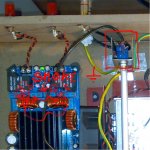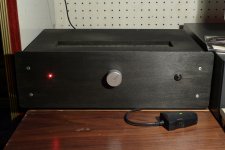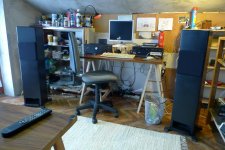In my opinion, there is harmless to short the inputs when input caps exist. But when you remove the caps, it's become complicate and we don't suggest try to do that.
And the outputs can not be shorted any time.
And the outputs can not be shorted any time.
shorted inputs
@hifimediy
Thanks, that's exactly what I thought. I'm just trying to understand what happened to my amp before sending it back. Just in case the fault was mine I don't want to make the same mistake twice when the new board arrives. At this point I can think of nothing else that I did wrong. So, I'm presuming that there was a faulty component(s) on the board.
-Steve
@hifimediy
Thanks, that's exactly what I thought. I'm just trying to understand what happened to my amp before sending it back. Just in case the fault was mine I don't want to make the same mistake twice when the new board arrives. At this point I can think of nothing else that I did wrong. So, I'm presuming that there was a faulty component(s) on the board.
-Steve
To be honest, I have to specify I'm not sure about the real cause...[I didn't try again!!!that smoke made me afraid!!]I never tried that before, so your experience could be a lesson to us.
I have to be more precise:
the pot I have has printed circuit terminals,but this one isn't on a board [I didn't have much money to spend on this, and in the shop where I bought some other material there was only this -good- stereo 50k log pot ]; the pot is on a grounded metal U...while I was working on the pot axis and knob, some of the wires around the terminals could have touched the metal support...so...ground loop?Short between LR channels?Really don't know, but however the result was not less than curious..
This is T4 now....
and my hand built bang for bucks system...[this is my lab/study-room
Attachments
Just a little follow up.
I'ts now 5 months that I'm driving my speakers (inefficent and low cost TQWT's, but homemade) with a T2 powered by a Connex 300R SMPS, all unmodified, in a power-amp setup (no volume control - stock pot all turned up).
I assembled it all following the guide user Alkasar wrote and posted on a french forum. Very well done. This alliance worked from the beginning, rock solid, no noise or hum at all (the low sensibility of the speakers and the distance between the SMPS and the T2 may help), no difficulties in handling fast transients or long listening sessions.
Soundwise I'm not missing my Denon and Rotel integrated amps at all, much more muddy and less detailed in the low-mids section, where the T2 is still capable of delivering a firm and solid bass. The highlight for me is the reproduction of acoustic instruments (as a half musician): as someone said earlier, you discover much more instruments in your favorite recordings (and the capabilities of the sound recording engineer) never loosing the music as a whole.
Power wise i feel it's better suited for high sensibility speakers (>92 db or so), but I'm still capable to reach normal to high listening volumes with my 86 db speakers in an average apartment living room (maybe 20 sq. m.) without any distortion.
I'm very happy with the result, time will tell about the quality of the used components and of my assembling skills, but from a first impression the two modules are clean, well manufactured and assembled. The only thing I miss is the ROHS compliance, but this discussion should be made in a separated thread.
I would recommend it to everyone with high expectations and basic skills, wanting to improve his own listening experience.
But beware, it's addictive. Once your defeat the marketing voodoo of big companies and you start to understand the (few) important rules of sound reproduction and electronics it's very difficult to stop.
I'ts now 5 months that I'm driving my speakers (inefficent and low cost TQWT's, but homemade) with a T2 powered by a Connex 300R SMPS, all unmodified, in a power-amp setup (no volume control - stock pot all turned up).
I assembled it all following the guide user Alkasar wrote and posted on a french forum. Very well done. This alliance worked from the beginning, rock solid, no noise or hum at all (the low sensibility of the speakers and the distance between the SMPS and the T2 may help), no difficulties in handling fast transients or long listening sessions.
Soundwise I'm not missing my Denon and Rotel integrated amps at all, much more muddy and less detailed in the low-mids section, where the T2 is still capable of delivering a firm and solid bass. The highlight for me is the reproduction of acoustic instruments (as a half musician): as someone said earlier, you discover much more instruments in your favorite recordings (and the capabilities of the sound recording engineer) never loosing the music as a whole.
Power wise i feel it's better suited for high sensibility speakers (>92 db or so), but I'm still capable to reach normal to high listening volumes with my 86 db speakers in an average apartment living room (maybe 20 sq. m.) without any distortion.
I'm very happy with the result, time will tell about the quality of the used components and of my assembling skills, but from a first impression the two modules are clean, well manufactured and assembled. The only thing I miss is the ROHS compliance, but this discussion should be made in a separated thread.
I would recommend it to everyone with high expectations and basic skills, wanting to improve his own listening experience.
But beware, it's addictive. Once your defeat the marketing voodoo of big companies and you start to understand the (few) important rules of sound reproduction and electronics it's very difficult to stop.
Just a little follow up.
Power wise i feel it's better suited for high sensibility speakers (>92 db or so), but I'm still capable to reach normal to high listening volumes with my 86 db speakers in an average apartment living room (maybe 20 sq. m.) without any distortion.
I think that if you take the T2 to maximum voltage and/or increase the gain a little bit, I'm fairly sure that it can work well with lower sensitivity speakers.
I would recommend it to everyone with high expectations and basic skills, wanting to improve his own listening experience.
But beware, it's addictive. Once your defeat the marketing voodoo of big companies and you start to understand the (few) important rules of sound reproduction and electronics it's very difficult to stop.
Well put!! Completely agree.
Hi, if the channel has no problem to play music, we can say the trimmer(R22/R23) or resistor RP1 on the bottom side is down/bad soldered.
Hi,
well I have checked the rp1 and the trimmers extensively. Everything seems to work as expected.
I have reflowed all the solder joints.
I am getting the whole range (0-5v) on the trimmers.
I have also reflowed the solder joints on the R1,R2,R3,R5 resistors.
All the values of the resistors I am measuring in circuit seen the same as on the properly functioning board.
And still everything is the same, I am getting 65mv on one channel.
What should I do next?
Lovro
I fully agree!!But beware, it's addictive. Once your defeat the marketing voodoo of big companies and you start to understand the (few) important rules of sound reproduction and electronics it's very difficult to stop.
Greetings,
I'm hooking up a T2 special version with Connexelectronic smps 300r (both purchased from hifimediy) and I'm slightly confused. The user manual (for the T2) says "for DC it does not matter where you connect + and -". My understanding from reading post by Christi of Connexelectronics is that + and - on single output voltage version of the smps300r are connected with a jumper so that they are both +. So my question is -- as it seems I can pick either the positive or negative spade and will get the same + output does the other terminal on the T2 get connected to the ground spade on the power supply?
Thanks
boone
I'm hooking up a T2 special version with Connexelectronic smps 300r (both purchased from hifimediy) and I'm slightly confused. The user manual (for the T2) says "for DC it does not matter where you connect + and -". My understanding from reading post by Christi of Connexelectronics is that + and - on single output voltage version of the smps300r are connected with a jumper so that they are both +. So my question is -- as it seems I can pick either the positive or negative spade and will get the same + output does the other terminal on the T2 get connected to the ground spade on the power supply?
Thanks
boone
Hi, noob here, probably with a question that will be annoying! Basically I don't have any experience with soldering and don't even own a iron, nor can I for the life of me work out what I would make an enclosure out of...I don't have a smelly old cigar box laying around. I'm just looking for a half decent ready to run amp based on the tk2050 IC, for use with my PC. Currently I've got a 2.1 set of Acoustic Energy Ageo M's:
http://www.amazon.co.uk/dp/B000MN96...de=asn&creative=22218&creativeASIN=B000MN96T6
Would one of these be an improvement:
NEW TOPPING TP22 TP-22 & TK2050 T-AMP 2X30W & Tripath Class | eBay
I realise this is far tamer than any of the 2*100/4*100 boards being discussed hear (and possibly more money) but I will absolutely 100% mess up with a DIY job and don't want something that looks like a 5yr olds project! BTW I do also own an Onkyo TX-SR606, 8 chan AV receiver but it is absolutely huge and I've heard it's not very musical (right now its in the garage--no space). I would also need some bookshelf's as I don't have anything appropriate right now, any low cost suggestions would be great!
http://www.amazon.co.uk/dp/B000MN96...de=asn&creative=22218&creativeASIN=B000MN96T6
Would one of these be an improvement:
NEW TOPPING TP22 TP-22 & TK2050 T-AMP 2X30W & Tripath Class | eBay
I realise this is far tamer than any of the 2*100/4*100 boards being discussed hear (and possibly more money) but I will absolutely 100% mess up with a DIY job and don't want something that looks like a 5yr olds project! BTW I do also own an Onkyo TX-SR606, 8 chan AV receiver but it is absolutely huge and I've heard it's not very musical (right now its in the garage--no space). I would also need some bookshelf's as I don't have anything appropriate right now, any low cost suggestions would be great!
You're confused with Power supply and amp board.Greetings,
I'm hooking up a T2 special version with Connexelectronic smps 300r (both purchased from hifimediy) and I'm slightly confused. The user manual (for the T2) says "for DC it does not matter where you connect + and -". My understanding from reading post by Christi of Connexelectronics is that + and - on single output voltage version of the smps300r are connected with a jumper so that they are both +. So my question is -- as it seems I can pick either the positive or negative spade and will get the same + output does the other terminal on the T2 get connected to the ground spade on the power supply?
Thanks
boone
connect like this and it will be ok 🙂

A quick question:
For a SMPS with low current (4.5A), would a 10000uF cap be more suited?
Trying to decide between the T1 CTR and T2 sta505 10000uF.
For a SMPS with low current (4.5A), would a 10000uF cap be more suited?
Trying to decide between the T1 CTR and T2 sta505 10000uF.
Hi,
well I have checked the rp1 and the trimmers extensively. Everything seems to work as expected.
I have reflowed all the solder joints.
I am getting the whole range (0-5v) on the trimmers.
I have also reflowed the solder joints on the R1,R2,R3,R5 resistors.
All the values of the resistors I am measuring in circuit seen the same as on the properly functioning board.
And still everything is the same, I am getting 65mv on one channel.
What should I do next?
Lovro
Hi, could you check the DC voltage from both OUT+ and OUT- to GND?
I have finalized my amp using the T4 and SMPS500R. When I switch it on nothing happens. The LED light on the T4 doesn't light up. I have attached a few photos below and would love some feedback on what the issue could be?
An externally hosted image should be here but it was not working when we last tested it.
An externally hosted image should be here but it was not working when we last tested it.
An externally hosted image should be here but it was not working when we last tested it.
The black power input you use , does it consit of switch - fuse ?
Is the fuse there.
Do you have any output from your power supply?
Is the fuse there.
Do you have any output from your power supply?
I have finalized my amp using the T4 and SMPS500R. When I switch it on nothing happens. The LED light on the T4 doesn't light up. I have attached a few photos below and would love some feedback on what the issue could be?
An externally hosted image should be here but it was not working when we last tested it.
An externally hosted image should be here but it was not working when we last tested it.
An externally hosted image should be here but it was not working when we last tested it.
Hi, noob here, probably with a question that will be annoying! Basically I don't have any experience with soldering and don't even own a iron, nor can I for the life of me work out what I would make an enclosure out of...I don't have a smelly old cigar box laying around. I'm just looking for a half decent ready to run amp based on the tk2050 IC, for use with my PC. Currently I've got a 2.1 set of Acoustic Energy Ageo M's:
http://www.amazon.co.uk/dp/B000MN96...de=asn&creative=22218&creativeASIN=B000MN96T6
Would one of these be an improvement:
NEW TOPPING TP22 TP-22 & TK2050 T-AMP 2X30W & Tripath Class | eBay
I realise this is far tamer than any of the 2*100/4*100 boards being discussed hear (and possibly more money) but I will absolutely 100% mess up with a DIY job and don't want something that looks like a 5yr olds project! BTW I do also own an Onkyo TX-SR606, 8 chan AV receiver but it is absolutely huge and I've heard it's not very musical (right now its in the garage--no space). I would also need some bookshelf's as I don't have anything appropriate right now, any low cost suggestions would be great!
Is there nobody with any input on this?
The black power input you use , does it consit of switch - fuse ?
Is the fuse there.
Do you have any output from your power supply?
The black power input does consist of switch and fuse (and it is present). I don't have a meter to measure output from the power supply. This is something I will need to get if the wiring looks fine.
The black power input does consist of switch and fuse (and it is present). I don't have a meter to measure output from the power supply. This is something I will need to get if the wiring looks fine.
Should the neutral (blue) go to the switch before the mains?
The black power input does consist of switch and fuse (and it is present). I don't have a meter to measure output from the power supply. This is something I will need to get if the wiring looks fine.
I strongly suggest you to find a meter and make sure the power is ok before connect to the amp board. Preparation may quicken your job🙂
- Status
- Not open for further replies.
- Home
- Amplifiers
- Class D
- New TK2050 board


